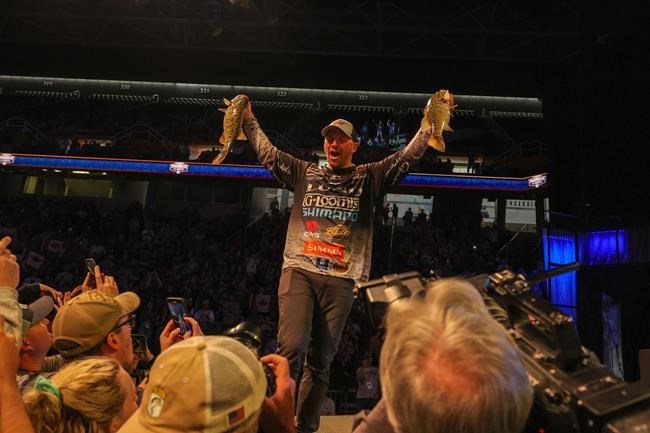It's not much to look at and about as exciting to watch as paint drying, but it's a technique Canadian Jeff Gustafson has parlayed into big success on the pro bass circuit.
On Sunday, the Kenora, Ont., angler became the first Canadian to win the US$1-million Bassmaster Classic. And he accomplished the historic feat by presenting a plastic shad bait on a jig just above bottom-hugging smallmouth bass.
That technique, called moping, secured Gustafson 12 smallmouths for a tournament-winning 42 pounds, seven ounces over three days.
Throughout the wire-to-wire victory on the Tennessee River, he repeatedly apologized to the television audience for "being boring."
After boating five-fish limits the first two days, Gustafson caught just two smallmouths Sunday weighing a combined six pounds, 12 ounces. They were crucial, though, as Gustafson's margin of victory was just one pound, nine ounces over American runner-up Bryan Schmitt, who boated five-fish limits all three days and 40 pounds, 14 ounces overall.
Gustafson earned the $300,000 winner's share plus $7,000 for weighing the tournament's heaviest bag (18 pounds, eight ounces Friday).
Two years earlier, Gustafson successfully applied the same approach on the same fishery, again going wire-to-wire in securing his first Elite Series victory.
"It's a technique I grew up doing for smallmouths and walleyes and have a lot of confidence in," Gustafson said. "I'd been waiting for years to do it in a tournament and I did the last time here and obviously I got to do it again."
Both times, Gustafson went against conventional wisdom. Many felt in '21 and again last weekend that a mixture of smallmouth and largemouth would be the winning formula.
Last weekend, many competitors went shallow chasing big largemouths that were poised to spawn. But that bite didn't really materialize.
"I'd caught some largemouths in practice and knew you could put a crankbait on and beat the bank and catch a few," Gustafson said. "But as calm as it was (Sunday) and as clear as the water was where I was fishing, I knew that wasn't going to be a real great gameplan.
"If it had been windy, maybe I could've fished stretches of the windy shore and maybe had a good chance to catch a few."
Gustafson's bait of choice was a four-inch, smelt-coloured Z-Man Jerk Shadz on a 3/8-ounce Smeltinator jighead presented either vertically or retrieved slowly. He used a seven-foot-three, medium action G Loomis NRX+ 872 rod with a Shimano Stella 3000 reel spooled with 10-pound PowerPro and 10-pound Shimano Mastiff fluorocarbon leader.
Gustafson said keeping the bait horizontal was key, which meant continually ensuring his knot hadn't slid on the jig eyelet and thus changed the presentation angle. Smallmouths would come up from bottom and examine the bait, which Gustafson watched in real time on his Mega Live sonar system.
"I probably saw 100 fish (Sunday), I was on fish all day," Gustafson said. "For sure, it was very frustrating . . . there were plenty of them down there, they just were hard to catch.
"But I didn't really consider changing (tactics) because I didn't have a good backup plan."
However, Gustafson did second-guess himself during the hour-long boat ride back to the weigh-in station.
"I had all kinds of bad thoughts about, 'I should've done this, I should've done that,'" he said. "But I stuck with it and just barely got enough.
"Thankfully I got two of them to bite."
Sometimes Gustafson kept his bait motionless, other times he'd move it slightly.
"If they were kind of eyeballing it, I'd just give the bait a little bit of a quiver," he said. "When they came slow, I pulled it up away from them a little bit sometimes.
"You'd get a lot of bumps where they'd hit it with their mouths closed. When they did that, I dropped it back down and started the quiver like it was an injured baitfish."
When Gustafson won his'21 Elite Series event, the Mega Live technology wasn't fully on the market. This time, though, he said it was a key element in his Classic victory.
"I know everyone doesn't love forward-facing sonar," he said. "But it's mandatory equipment if you want to compete with these guys.
"Everyone has it and if you don't, you're not even going to come close to competing."
And long after being presented the Ray Scott Trophy, Gustafson said his victory remains surreal.
"It's insane," he said. "It's the highlight of my fishing career by one million times . . . I wish I could've spoken a little better onstage.
"There are many good anglers (in Canada), a lot of people who love bass fishing in Canada. So, this is for everybody up there."
This report by The Canadian Press was first published March 27, 2023.
Dan Ralph, The Canadian Press



